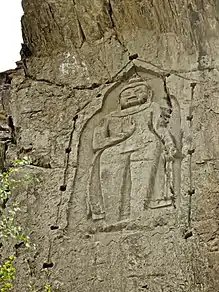Kargah Buddha
Kargah Buddha (Urdu: کارگاہ بدھ; Shina: Yʂhani یݜنی) is an archaeological site located about 6 miles (9.7 km) outside of Gilgit, Gilgit-Baltistan, Pakistan.[2] It is a carved image of a large standing Buddha, some 50 feet high, in the cliff-face in Karghah Nala.[3][4] The carving, which is in a style also found in Baltistan, probably dates to the 7th century.[4]
 Carved image of Buddha | |
| Location | Gilgit |
|---|---|
| Region | Gilgit-Baltistan |
| Width | Varies |
| Height | 50ft[1] |
| History | |
| Periods | 7th century |
| Cultures | Buddhism |
| Site notes | |
| Ownership | Ministry of Tourism (Pakistan) |
| Public access | Open |
| Website | www.gilgit.gov.pk |
The image is surrounded by the holes for a wooden "image house" structure, which would have sheltered it from the weather.
Location
Kargah Buddha is located at the junction of two rivulets or ravines, the Kargah and Shukogah, about 6 miles (9.7 km) west of the town of Gilgit.[4][5] Nearby locales include Barmas village, Rakaposhi mountain, and Napur.[4]
From the 3rd century to the 11th century, Gilgit was a Buddhist center.[2] Nearby, about 400 metres (1,300 ft) upstream, a Buddhist monastery and three stupas containing Sanskrit manuscripts were excavated in 1931.[2] During this time period, multiple nations vied for control of the region, including the Tibet, Kashmir, and the Arabs.[2] By the 11th century, Gilgit had grown into the autonomous kingdom of Dardistan before accepting Islam.[2]
Carving
It is estimated that the carving was completed in the 7th century.[4] It was discovered in 1938–39, following the innovation of supposed Gilgit manuscripts in 1931.
According to local legend, the figure is actually a man-eating giantess or witch (yakhshini or ya-chaani or yacheni) who terrorized the local residents and was ultimately pinned to the cliff by a pir (holy man) as punishment.[4][6][7]
References
- "Kargha Buddha site – a true picture of neglect". Associate Press of Pakistan. 8 September 2016.
- Bernier, Ronald M. (1997). Himalayan architecture. Cranbury, NJ: Associated University Press. pp. 180. ISBN 9780838636022.
- "Sustainable Tourism and Cultural Heritage" (PDF). Bakhtiar Ahmed. IUCN, Northern Areas Programme. Archived from the original (PDF) on July 5, 2014. Retrieved July 5, 2014.
- King, John S. (1989). Karakoram Highway: the high road to China, a travel survival kit. Berkeley, CA: Lonely Planet. pp. 130. ISBN 978-0864420657.
- Tsuchiya, Haruko (September 1991). "Preliminary report on field research along the Ancient Routes in the Northern Areas of Pakistan and related historical and art historical information". Journal of the Japanese Association of South Asian Studies. 5: 1–38. Archived from the original on January 1, 2019.
- Radloff, Carla F.; Shakil, Shakil Ahmad (1998). Folktales in the Shina of Gilgit. Islamabad: Summer Institute of Linguistics and National Institute of Pakistan Studies. p. 2. ISBN 969-8023-04-6.
- Dad, Aziz Ali (February 14, 2017). "The making of a witch". The News International. Retrieved January 1, 2019.